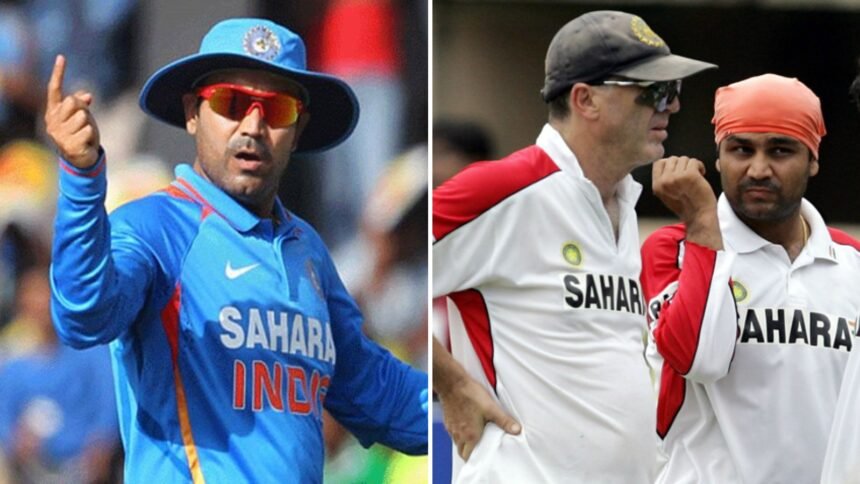Former India opener Virender Sehwag was a true-blue trailblazer with the bat in his prime. It is not surprising, then, to know that the ‘Nawab of Najafgarh’ still holds some staggering international records, even after a decade into retirement.
Sehwag’s manic strike-rates and appetite for daddy-hundreds were a distinct feature of his international career across formats. He remains the only opener to record 7,500 runs in both ODIs and Tests and is also the only one of four Test batters in history to record two triple-centuries, while also scoring the fastest 300 in the format. Sehwag’s bold and brazen approach had a demoralising effect on the opposition bowlers, but even the Delhi star could sometimes take the ‘swagger’ a touch too far.
A doomed double hundred prediction
In the lead-up to India’s 2004 Asia Cup, Sehwag shared a prophecy and an immediate target before the reporters in Dambulla ahead of the opening round game against the United Arab Emirates.
“If I stay at the crease for 50 overs, I can score a double-century. “In fact, a lot of batsmen can do it provided they bat full 50 overs,” Sehwag said.
“It is certainly not easy to score a double-century in one-dayers, but it is also not impossible,” added Sehwag at a time when Pakistan opener Saeed Anwar’s 194 from 1997 held the top spot in ODIs.
The age-old saying of ‘cricket being a great leveller’ was to take action that week. Four days later, in India’s opening fixture against the UAE, Sehwag fell for a three-ball duck and went on a horrendous slump. His following scores in the tournament were: 37, 16, 1, 81 and 5. The dashing right-hander’s blazing guns, in fact, would go cold throughout the year — 671 runs at 25.80 in 26 innings would mark Sehwag’s worst ODI season between 2001 and 2011, with his average at its lowest across any year in the decade.
‘Cricket will take the piss out of you’
In his book, ‘Indian Summers’ released three years later in 2007, John Wright, the Indian head coach between 2000-05, particularly lambasted Sehwag’s cocky remarks in the media prior to the Asia Cup tournament.
Story continues below this ad
“When we regrouped in 2004 it was like the post-World Cup hangover, only worse. After winning in Pakistan, it was being said this was the best Indian team ever, and the air the players breathed had become even more rarefied,” wrote Wright.
“In the land that traditionally hero-worshipped great batsmen, even our quick bowlers Irfan Pathan and Lakshmipathy Balaji had become cult heroes. Our first assignment, the Asia Cup, was regarded as a fait accompli and there was a bit of swaggering in the media, such as Virender Sehwag suggesting that he could score 200 in an ODI if he batted 50 overs.
“It reminded me of what my old Derbyshire captain, the South African all-rounder Eddie Barlow, said to me after I’d followed a big 100 with three soft failures: ‘If you take the piss out of cricket, cricket will take the piss out of you.’ In his first 13 ODIs that season Sehwag got one 50,” Wright added.
Sehwag’s jinxed prediction would not, however, dash to flames as he would earn his redemption seven seasons later at the twilight of his international career. In the December of 2011, months after India’s ODI World Cup triumph, Sehwag sent the West Indies bowlers on a magnificent leather hunt at the Holkar Stadium in Indore.
Story continues below this ad
Leading the side in the absence of MS Dhoni, Sehwag walloped a gigantic 219 in only 146 deliveries, clubbing 25 fours and seven sixes – the highest individual score by an ODI captain. He propelled India to their highest-ever total (418/5) in ODIs and became only the second man after Sachin Tendulkar to record an ODI double century.
Curiously, it would also turn out to be Sehwag’s last ODI hundred. Though he didn’t bat out the entire quota of 50 overs, there was consolation in the winter of 2011 for his bold Asia Cup declaration, seven seasons ago.








